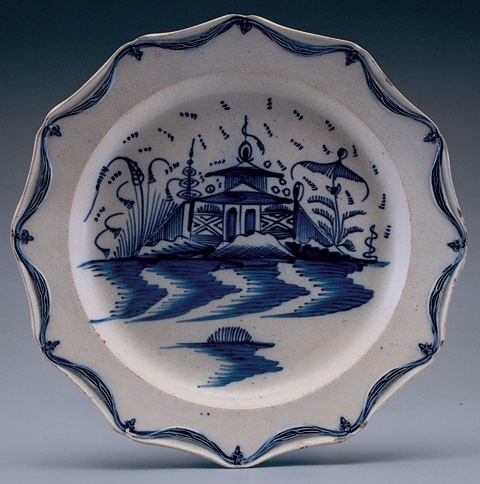
Plate, probably Staffordshire, ca. 1790. China glaze. D. 10". (All objects private collection, unless otherwise noted; all photography Gavin Ashworth, unless otherwise noted.) China glaze is most often associated with underglaze chinoiserie decoration. Unfortunately, these early China glaze wares were rarely marked by their manufacturers. One painted design appears to have been standardized by the English potters which Ivor Noël Hume and others have called the “Chinese house pattern.” Innumerable variants of this design exist. The common thread between them is the formulaic layout of the pattern’s primary features: trees, fence, house or pagoda, fence, and more trees. The foreground almost always consists of shimmering water with assorted rocks and plants. Although the specific origin of the pattern is unknown, it appears to have been adapted from chinoiserie patterns painted on English porcelains of the 1750s and 1760s rather than directly from Chinese prototypes.
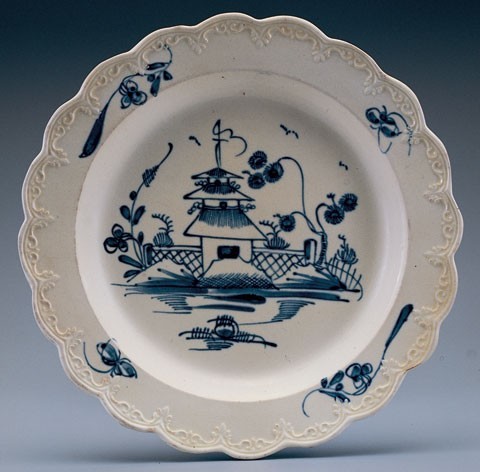
Plate, probably Staffordshire, 1775–1790. Creamware. D. 9 3/4". An example of the Chinese house pattern on a creamware plate with unusual molded rim. Cobalt decoration on the cream-colored ware does not successfully mimic the look of Chinese or English blue-and-white porcelain.

Bowl, Worcester, 1770–1780. Soft-paste porcelain. D. 11". This punch bowl is painted in a pattern that has been called “Rock Strata Island.” The Caughley porcelain factory made an identical version of this pattern.
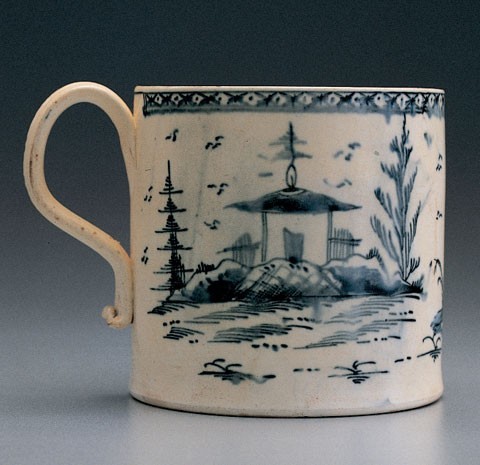
Mug, Staffordshire or Yorkshire, 1777. Creamware. H. 4". (Collection of Troy D. Chappell.) An early example of the Chinese house pattern on a creamware body.
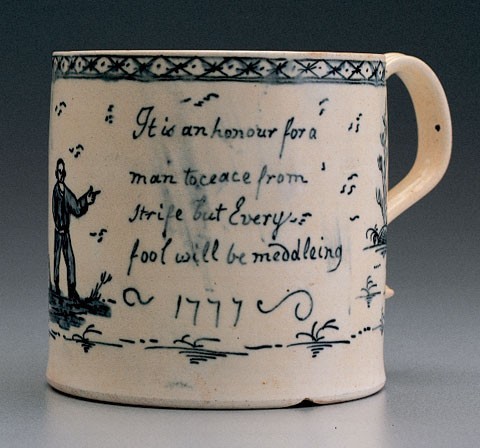
Reverse of the mug illustrated in fig. 4. (Collection of Troy D. Chappell.) The painted inscription reads: “It is an honour for a / man to ceace from/ strife but Every / fool will be meddling/ 1777.” The date on this mug demonstrates that blue-painted chinoiserie patterns were being produced on earthenware before Josiah Wedgwood’s introduction of Pearl White in 1779.

Punch bowls. (Left): Leeds pottery, ca. 1780. China glaze. D. 10". (Right): Yorkshire or Staffordshire, 1777. Creamware. D. 8". (Courtesy, Colonial Williamsburg Foundation.) These bowls exemplify the close relationship between China glaze and the creamware bodies.

Interiors of the punch bowls illustrated in fig. 6. (Courtesy, Colonial Williamsburg Foundation.) The decorated interiors of these bowls are reminiscent of inscribed delft punch bowls. The inscription on the left reads “May the / Evening Deversion [sic] / bear the / Mornings [sic] Reflection.” The interior of the bowl on the right has a coat of arms with “1777” and “I. N.”
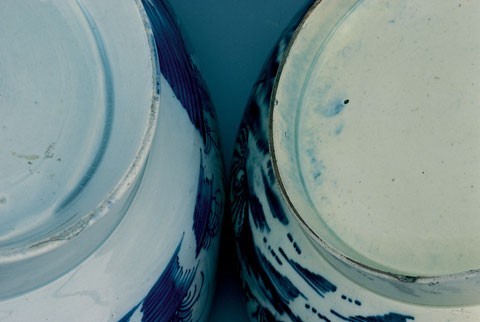
Detail of the foot rings of the punch bowls illustrated in fig. 6. (Courtesy, Colonial Williamsburg Foundation.) The pooling of cobalt in the foot ring is clearly evident in both examples.
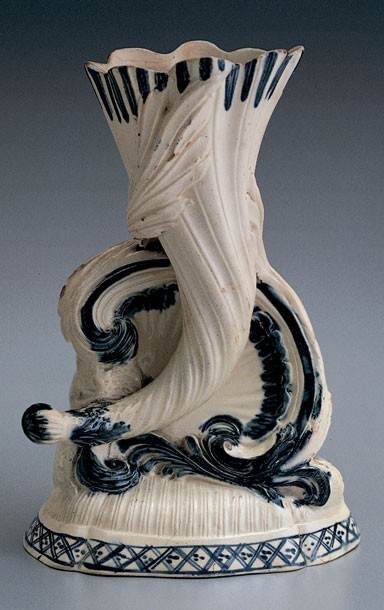
Spill vase, Yorkshire or Staffordshire, ca. 1775. Creamware. H. 6 7/8".
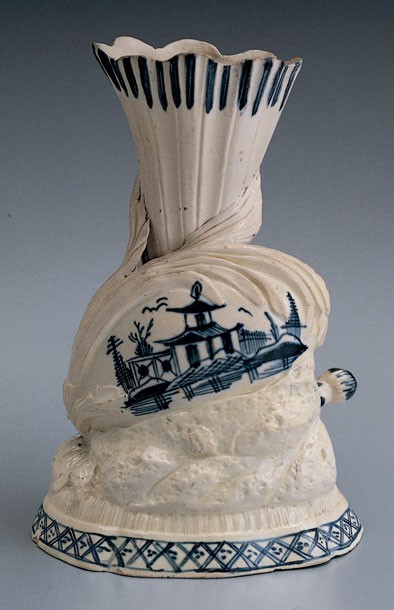
Reverse view of the spill vase illustrated in fig. 9. This early example combines elements of rococo design with the odd juxtaposition of the Chinese house pattern on the reverse of this molded vase.

Mugs, Staffordshire or Yorkshire, 1775–1810. China glaze. H. 4 1/2" to 6". Mugs are among the most commonly recovered China glaze forms on American archaeological sites.
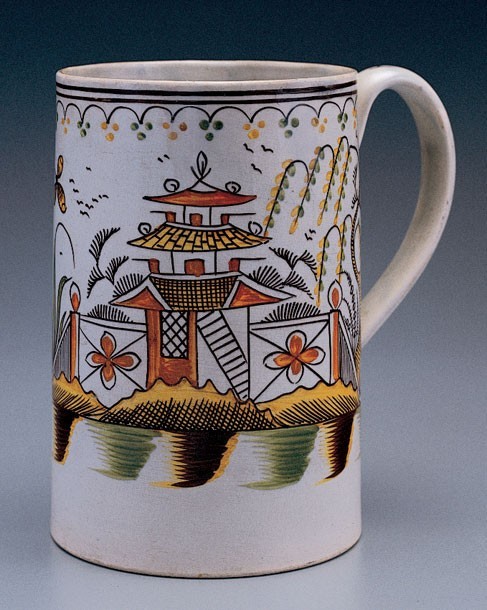
Mug, Staffordshire or Yorkshire, ca. 1790–1810. China glaze. H. 6 1/4". Polychrome-painted China glaze mugs are much less common than blue-painted ones. The introduction date for underglaze-painted colors has not been documented. One reason that polychrome pieces may be less common is that blue-painted patterns began twenty years before the polychrome-painted patterns were introduced.
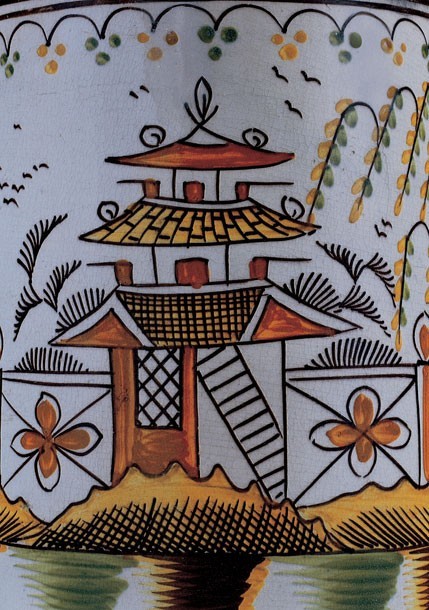
Detail of the underglaze pattern on the mug illustrated in fig. 12.

Mug, Staffordshire or Yorkshire, 1790–1810. China glaze. H. 5 1/4". Another example of underglaze polychrome decoration used in combination with blue painting.

Coffee pots, Staffordshire or Yorkshire, 1780–1810. China glaze. H. 12 1/8" and 7 3/8". Coffee pots are much less common than teapots in all painted and printed wares. The example on the left is unusual in that it has traces of original gilding.
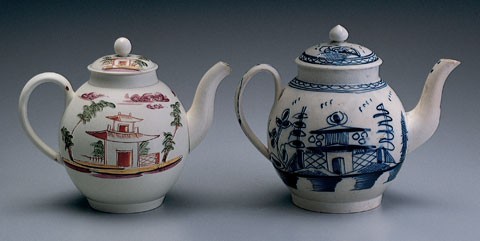
Teapots, Staffordshire or Yorkshire, 1775–1800. China glaze. H. 6" and 6 1/2". Egg-shaped teapots were common forms associated with the Chinese house pattern. The example on the left is unusual in having an overglaze enamel decoration.
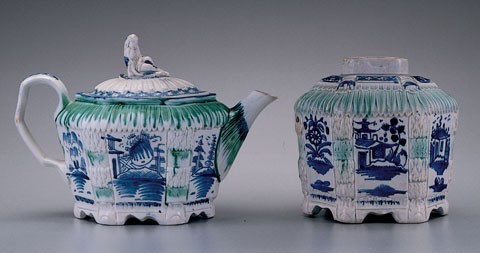
Teapot and tea canister, Staffordshire or Yorkshire, 1790–1810. China glaze. H. of teapot: 5 3/8". An interesting use of the Chinese house pattern on a neoclassical form.
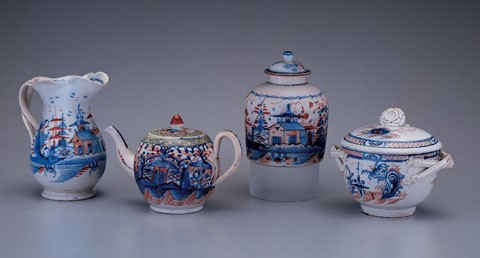
A group of tea wares, probably Staffordshire, 1775–1785. China glaze. H. of cream jug: 4 5/8". For a short period of time, some China glaze tea wares were decorated with overglaze enameling and gilding in imitation of the Imari porcelains. Although no records exist, these were undoubtedly more costly China glaze items.
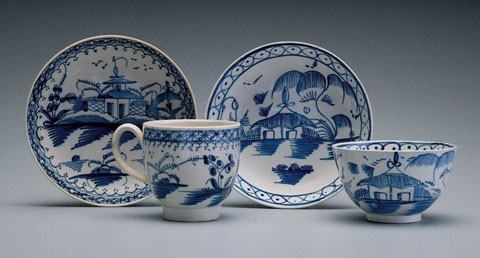
Coffee cup and saucer, and tea bowl and saucer; Staffordshire or Yorkshire, 1775–1810. China glaze. H. of coffee cup: 3 1/4". Tea bowls and saucers appear frequently in the American archaeological record. They are far more common than China glaze plates and mugs. Most cups are handleless and in a Chinese tea bowl shape. Handled coffee cups are quite rare, however. We have not seen any marked or dated pieces of this form.
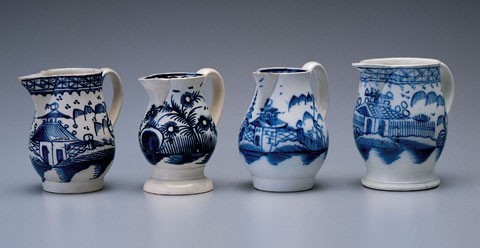
Cream jugs, Staffordshire or Yorkshire, 1775–1810. China glaze. H. 3 1/8" to 3 3/8". Cream jugs were made in a tremendous variety of shapes. Note the four different types of pouring lips. These shapes mimic the larger jug forms of the period.

Cream jugs. (Left): probably Staffordshire, ca. 1775. Creamware. H. 3 1/2". (Right): Staffordshire or Yorkshire, 1790–1820. China glaze. H. 3 1/4". The example on the left is enamel-decorated in a European-style house pattern. The jug on the right is decorated under the glaze in a debased chinoserie pattern.
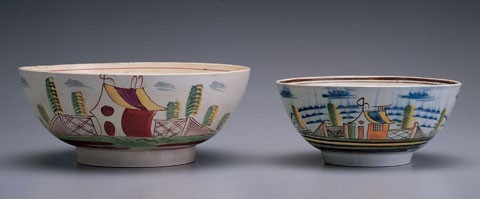
Punch bowls. (Left): probably Staffordshire, ca. 1775. Creamware. D. 8 7/8". (Right): Staffordshire or Yorkshire, 1790–1810. China glaze. D. 6". The creamware punch bowl is enamel-decorated in a European-style house pattern. The pearlware bowl is decorated in polychrome colors under the glaze.
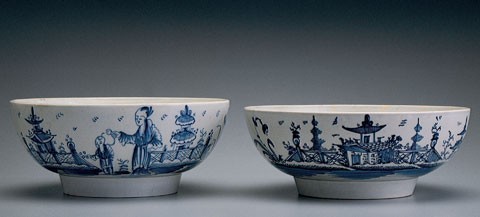
Punch bowls, Staffordshire or Yorkshire, 1775–1810. China glaze. D. 9 1/4" and 9 7/8". Punch bowl forms in a wide variety of sizes appear ubiquitously in American archaeological sites.
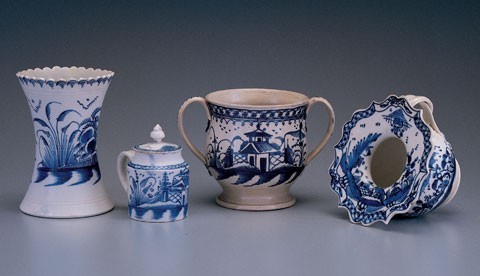
Various China glaze forms. Left to right: spill vase, mustard pot, two-handled cup, and spitting cup; Yorkshire or Staffordshire, 1775–1810. China glaze. H. of vase: 6 1/4". Almost every imaginable form appears to have been made and decorated in the Chinese house pattern between 1775 and 1820. Blue-printed patterns continued to be used on virtually every form produced by the English potting industry well into the nineteenth century.
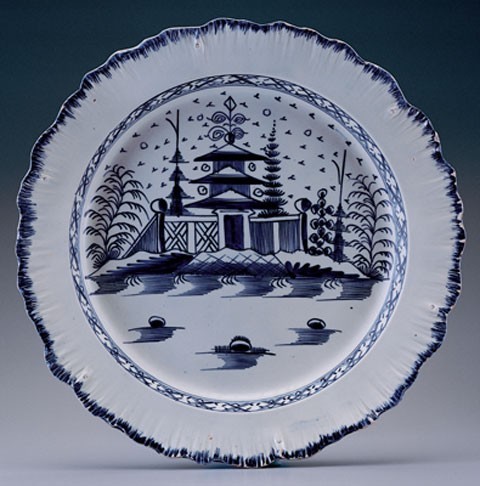
Dish, Staffordshire or Yorkshire, 1775–1810. China glaze. D. 14 1/2". A large, shell-edged serving dish painted with a very elaborate Chinese house pattern.
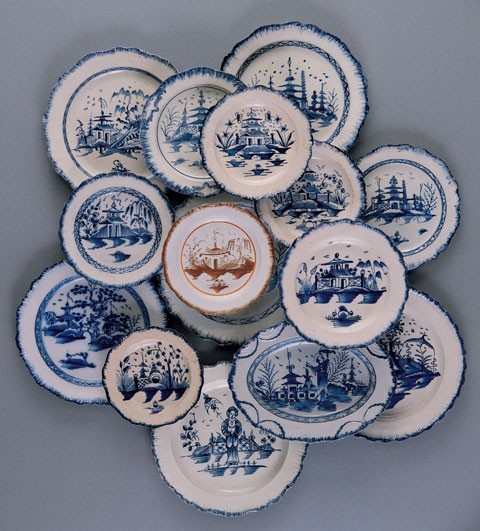
Plates and dishes, Staffordshire or Yorkshire, 1775–1810. Creamware and China glaze. As suggested in this grouping, tremendous variations of the Chinese house pattern were used in conjunction with the shell-edged rim treatment on both creamware and pearlware dishes. This assemblage provides strong evidence that many potters produced these wares. They are almost never marked, generally have rococo blue shell-edged rims, and date from 1775 to 1800. The introduction of underglaze transfer printing in Staffordshire in 1784 may have reduced the market for Chinese house pattern painted wares. The occurrence of plates and other tableware painted with the Chinese house pattern is relatively rare in the American archaeological record. Conversely, large numbers of antique plates and dishes seem to survive in England. This dissimilarity, perhaps reflecting a difference in the market, warrants further investigation.

Plate, Staffordshire or Yorkshire, 1785–1810. China glaze. D. 93/4". A variant of the Chinese house pattern on a pearlware plate; the rim decoration simulates molded relief panels and reserves. This rim type suggests a date after 1785.

Plates, Staffordshire or Yorkshire, 1775–1810. Creamware and China glaze. These dinner plates, decorated with the Chinese house pattern, all have different molded or painted rim treatments. Some of these rim treatments are shared by undecorated creamware patterns.

Plate, impressed “IH” for Joshua Heath of Tunstall, Staffordshire, ca. 1790. China glaze. D. 8". A black-printed China glaze shell-edged plate copying a Chinese pattern. This pre-Willow pattern print is line engraved. The “IH” mark is one of the few seen on China glaze wares.
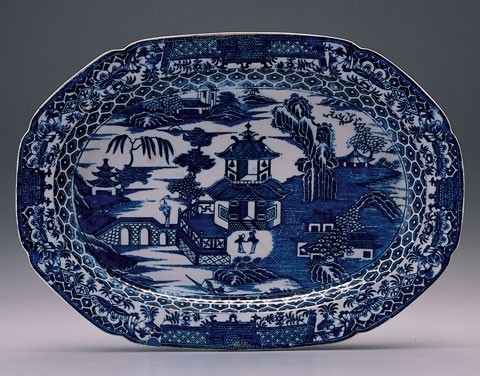
Dish, impressed “IH” for Joshua Heath of Tunstall, Staffordshire, ca. 1790. China glaze. L. 15 1/2". (Courtesy, Chipstone Foundation.) A blue-printed example of the same print illustrated in fig. 29.

Bowl, Ching-tê-chên, China, 1785–1820. Hard-paste porcelain. D. 4 3/8". Blue-painted Chinese bowl in what collectors call the “Canton” pattern or ware. The Canton pattern is one of the most simplified of the well-known Chinese porcelain export wares for the West. It is commonly dated as beginning around 1785 when Americans began trading with China. Given the simplicity of this pattern, one wonders if it is a copy of some of the China glaze wares being made in Staffordshire. Is it a Chinese copy of an English earthenware copy of English porcelain that was a copy of Chinese porcelain? How may times has the compass spun?
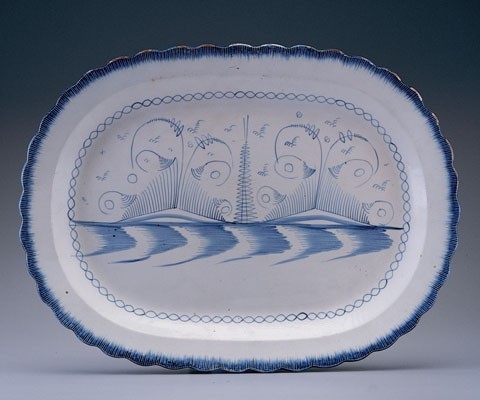
Dish, probably Staffordshire, ca. 1820. China glaze. L. 18 1/2". A debased version of the Chinese house pattern painted on a shell-edged dish of about 1820, possibly even as late as 1830. Note that the “house” and “fences” are missing elements of the design. This design is identical to the one on the small creamware jug illustrated in fig. 21.

Jug, possibly Lancastershire, 1821. China glaze. H. 9". (Courtesy, Chipstone Foundation.) The elaborate painting on this jug would suggest a much earlier date than the one inscribed on this presentation piece.
